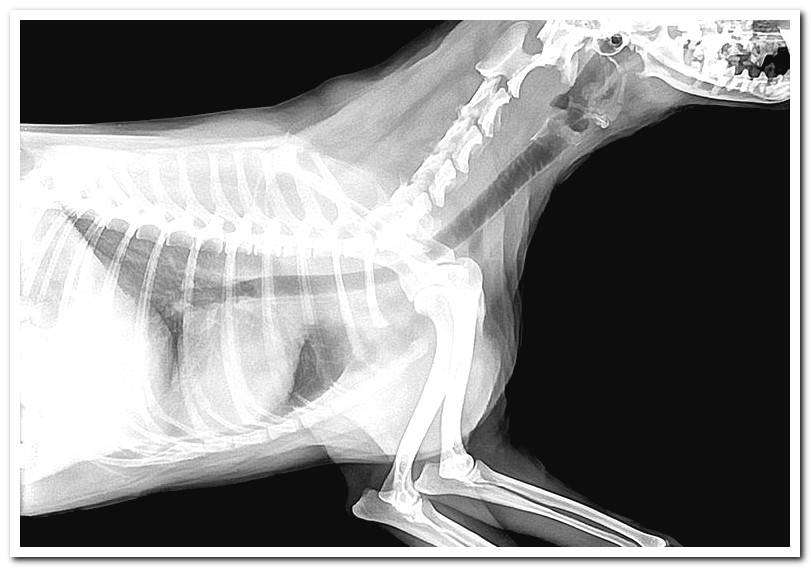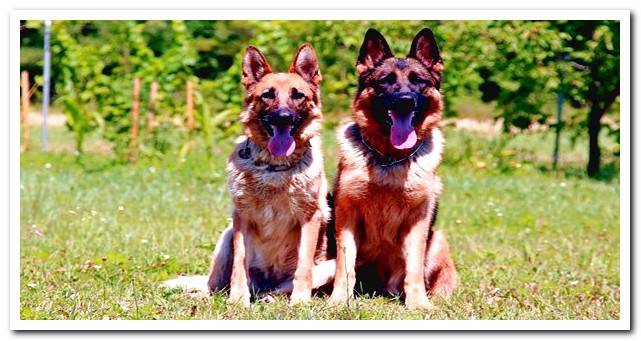
Did you know that the elbow is one of the most complex joints a dog has? In fact, if this part of your body does not develop properly, degenerative diseases can appear that prevent you from moving normally. One of the most frequent is elbow dysplasia in dogs.
Index of contents
- 1 How to detect it? Symptoms of Elbow Dysplasia in Dogs
- 2 Treatment and operation of elbow dysplasia in dogs
- 3 Postoperative care
- 4 Canine elbow dysplasia and its relationship with osteoarthritis
How to detect it? Symptoms of Elbow Dysplasia in Dogs
An inadequate diet during the growth of the dog, trauma or too intense physical exercise can trigger elbow dysplasia, although in most cases the hereditary factor carries a lot of weight.
There are several breeds of dogs genetically predisposed to this condition, which mainly affects large and fast growing giant dogs. These include: the german shepherd, The farmer, the dog Saint Bernard, the Golden Retriever, the Newfoundland, the Bernese Mountain Dog or the Neapolitan Mastiff.

The first symptoms of the disease can be detected from four months of age, although sometimes we do not realize it until the dog reaches adulthood. The most obvious clinical signs of canine elbow dysplasia are:
- Our furry refuses to perform physical activities that require effort.
- Limps when starting to move or after exercising.
- Pain that worsens with age and certain weather conditions such as cold or humidity (osteoarthritis).
- Changes in your behavior and activity level.
- Inflammation of the elbows and loss of range of motion of the limb.
These problems also occur in other types of canine diseases, such as hip dysplasia. Therefore, it is important to go to the vet so that he can do some radiological tests and give us a diagnosis.
If there are doubts, the specialist may also want to do a T.A.C to see if there are more associated pathologies.
Treatment and operation of elbow dysplasia in dogs
The treatment will depend on the particularities of each case. If the injury is not serious, or if you cannot opt for surgical treatment, the vet will recommend administering pain relievers and other medications to strengthen the joints.
There are also some devices that are placed on the dog’s body (orthosis), which can be of great help. Its function is to stabilize and protect the elbow with dysplasia, improving its mobility.
In severe cases of osteoarthritis injections of platelet-rich plasma may be used and mother cells. When these measures are insufficient, it is when the possibility of operating is valued.
The type of surgery will depend on the type of elbow dysplasia that has been diagnosed and whether there is mild or severe fragmentation of the bones and cartilage due to osteoarthritis.
Based on this, the surgeon will extract the damaged part with a minimally invasive technique or implant a prosthesis to improve the quality of life of our furry.

Postoperative care
After an intervention of this type, it is important to follow all the instructions that the vet gives you. Give him the drugs he prescribes, do not neglect the cures of your furry and take him to all the revisions that are necessary.
In addition, doing a good rehabilitation to speed up the recovery process, reduce pain, inflammation and the effects of joint degeneration will be key.
Massages and physical therapy sessions with an expert will help you feel better and better, avoiding loss of mass and tone.
Other useful tips during this phase are:
- Prevents the dog from having to move across slippery floors, ramps or stairs.
- Make sure you have a comfortable surface to lay on.
- Try to keep your skin dry and clean.
- Provide a correct diet and control the weight of your furry. The extra kilos cause more pain and make recovery difficult.
- Use a plate of food that doesn’t force you to strain your elbow joints.
With all these recommendations and a proper exercise routine, you are sure to feel much better soon.
Canine elbow dysplasia and its relationship with osteoarthritis
Elbow dysplasia in dogs is closely related to osteoarthritis. When an ossification defect occurs during growth, the ulna and radius are not in the correct position.
This causes joint incongruity and inflammation that leads to osteoarthritis. That is, to a degeneration of the cartilage that aggravates the disease, especially in advanced ages.
Curiously, elbow dysplasias usually affect males more than females and can occur only in one or both elbows. In any case, an early diagnosis will avoid the formation of osteoarthritis, saving you the pain and the limitations that it produces.
For all these reasons, it is important that if the dog belongs to a breed prone to elbow dysplasia, as a puppy you provide him with adequate food and be careful to avoid future problems.
